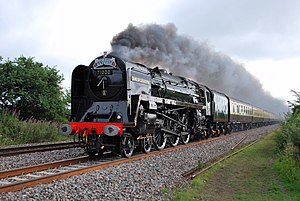BR Standard Class 8

No.71000 "Duke of Gloucester" hammering across the Somerset Levels on the Torbay Express.
|
|||||||||||||||||||||||||||||||||||||||||||||||||||||||||
|
|||||||||||||||||||||||||||||||||||||||||||||||||||||||||
|
|||||||||||||||||||||||||||||||||||||||||||||||||||||||||
|
|||||||||||||||||||||||||||||||||||||||||||||||||||||||||
|
|||||||||||||||||||||||||||||||||||||||||||||||||||||||||
| Type and origin | |
|---|---|
| Power type | Steam |
| Designer | Robert Riddles |
| Builder | BR Crewe Works |
| Build date | April 1954 |
| Total produced | 1 |
| Specifications | |
|---|---|
| Configuration: |
|
| • Whyte | 4-6-2 (Pacific) |
| • UIC | 2′C1′h3 |
| Gauge | 4 ft 8 1⁄2 in (1,435 mm) standard gauge |
| Leading dia. | 3 ft 0 in (0.914 m) |
| Driver dia. | 6 ft 2 in (1.880 m) |
| Trailing dia. | 3 ft 3 1⁄2 in (1.003 m) |
| Length | 67 ft 8 in (20.62 m) |
| Width | 9 ft 0 in (2.74 m) |
| Height | 13 ft 0 1⁄2 in (3.98 m) |
| Axle load | 22.00 long tons (24.64 short tons; 22.35 t) |
| Adhesive weight | 66.00 long tons (73.92 short tons; 67.06 t) |
| Loco weight | 101.25 long tons (113.40 short tons; 102.87 t) |
| Tender weight | BR1E: 55.50 long tons (62.16 short tons; 56.39 t) BR1J: 53.70 long tons (60.14 short tons; 54.56 t) |
| Tender type | 1954–1958: BR1E 1958–1962: BR1J |
| Fuel type | Coal |
| Fuel capacity | 10 long tons (11 short tons; 10 t) |
| Water cap | BR1E: 4,725 imp gal (21,480 l; 5,674 US gal) BR1J: 4,325 imp gal (19,660 l; 5,194 US gal) |
| Firebox: • Firegrate area |
48.6 sq ft (4.52 m2) |
| Boiler | BR13 |
| Boiler pressure | 250 psi (1.72 MPa) |
| Heating surface: • Tubes and flues |
2,264 sq ft (210.3 m2) |
| • Firebox | 226 sq ft (21.0 m2) |
| Superheater: |
|
| • Heating area | 677 sq ft (62.9 m2) |
| Cylinders | Three |
| Cylinder size | 18 in × 28 in (457 mm × 711 mm) |
| Performance figures | |
|---|---|
| Tractive effort | 39,080 lbf (173.84 kN) |
| Factor of adh. | 3.78 |
| Career | |
|---|---|
| Operators | British Railways |
| Power class | 8P |
| Numbers | 71000 |
| Locale | London Midland Region |
| Withdrawn | December 1962 |
| Disposition | Preserved |
The BR Standard Class 8 was a class of 4-6-2 Pacific steam locomotive designed by Robert Riddles for use by British Railways. Only the prototype was constructed, which was named Duke of Gloucester. Constructed at Crewe Works in 1954, the Duke, as it is popularly known, was a replacement for the destroyed LMS Princess Royal Class locomotive number 46202 Princess Anne, which was involved in the Harrow and Wealdstone rail disaster of 1952.
The Duke was based on the BR Standard Class 7 Britannia design. It incorporated three sets of modified Caprotti valve gear, relatively new to British locomotive engineering and more efficient than Walschaerts or Stephenson valve gear. The Duke was regarded as a failure by locomotive crews due to its poor steaming characteristics and its heavy fuel consumption. Trials undertaken by British Railways also returned negative feedback, reporting problems with the poor draughting of the locomotive which resulted in difficulty adhering to the timetables.
The result was an operational period of only eight years. This unique locomotive was saved from being scrapped at Woodham Brothers scrapyard in Barry, Vale of Glamorgan, South Wales when it was purchased by a group of railway enthusiasts who restored it from scrapyard to as-built condition in 13 years. Since then, modifications have been made to the original design, resulting in one of the most efficient and powerful steam locomotives ever to run in Britain. As a result, the Duke of Gloucester can frequently be seen on the mainline around Britain.
Riddles had frequently argued the case for the inclusion of a Standard Class 8 Pacific into the standard range of locomotives being introduced by British Railways. However, these proposals were rejected by the Railway Executive on the grounds of cost in attempting to develop a form of steam motive power that was not necessarily required for use on Britain's railways, as there were enough class 8 locomotives already available for use. However, opportunity came out of adversity when the short-lived rebuild of The Turbomotive, 46202 Princess Anne, was destroyed in the Harrow and Wealdstone rail disaster of 1952. A gap now existed in the roster for locomotives with 8P power classification, of which the demand was high for the efficient operation of heavy expresses on the West Coast Main Line between London Euston and Scotland. This presented Riddles with the perfect opportunity to press the case for his new design, a prototype of which was duly authorised for construction.
...
Wikipedia
